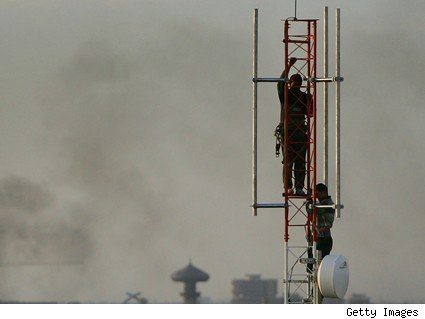It’s been more than five years since OSHA called tower climbing “the most dangerous job in America,” but there are indications that the fatality rate remains high. So far this year, 12 people have died while working on cell towers, according to Wireless Estimator, making this the deadliest year for climbers since 2008.
Last year an investigation by ProPublica found that 93 people died working on communications towers during the years 2002-2011. Matthew Vincent, safety coordinator for Eastern Communications, says that 55 of the tower climber deaths that have occurred during the past 10 years have been a direct result of free climbing – scaling cell towers without a safety line. Free climbing can be faster and easier than climbing with a line.
“When I got started in this industry … free climbing was taught. … This was the world that a lot of us stepped into,” said Vincent. Today, none of the largest contractors encourage or condone free climbing, but the practice continues, especially among more experienced climbers. “Sometimes, it’s the guy who’s been climbing for ten years who’s a little too comfortable,” said Matt Glass, executive vice president of network services at Nexius, which handles large contracts for AT&T and Sprint. “We know not to free climb,” said Glass, but that doesn’t mean it isn’t happening.
Deadline pressure is one of the major reasons climbers may be tempted to free climb. Carriers feel pressure to complete network upgrades ahead of the competition, and that pressure often finds its way to the job site. Industry executives say better planning can eliminate some of the deadline pressure. “If cutting a corner is the only way that you’re going to meet a deadline that your company has set for you, then that deadline was never possible in the first place,” said Vincent.
The industry needs to become “better at managing the outcome and not reacting and rushing,” said Rick Suarez, president of MasTec Network Solutions. MasTec handles wireless construction contracts for the Tier 1 carriers, and Suarez says his company has recently made significant investments in safety training, including construction of a dedicated safety center with training towers.
“One thing is to be certified to work aloft and another thing is to demonstrate that you can work aloft,” explains Suarez. He said certifications on paper can mean much less than demonstrated expertise, which includes “working with the tools you are supposed to be working with, … setting up the structure, … mounting the antennas, and ultimately having a drill sergeant at the end of the day saying ‘you’re ready to go and you said you were a Tech 3 but guess what – we’ve just rated you a Tech 1.’ ”
But not all tower technicians work for large companies like MasTec. Many work for much smaller businesses that contract with carrier representatives to build, maintain, or upgrade towers. Safety protocols can vary widely from company to company. Safety coordinator Matthew Vincent says that safety outcomes are often dependent on the choices made by the crew’s foreman, who must balance deadline pressure with safety concerns. “If that foreman is not under the understanding that safety has to be there, regardless of how fast you do things, that foreman’s going to push his guys,” said Vincent.
Vincent says the carrier’s general contractor, or “turf vendor” needs to designate someone to oversee each job site. “You’ve got to have safety visits, you’ve got to pop in on these guys and say ‘Hey we care what you’re doing out here and how you’re doing it,'” said Vincent.
But, ultimately, each individual climber is responsible for keeping himself safe. “Each climber has to be personally responsible for his own safety. When something feels wrong, it usually is, so speak up and say something,” Vincent advised. “If a climber feels that he’s being pushed and the only way to make that push happen as quick as they want it to is to cut corners, he needs to bump that right back up the line, and know, and have the ability in himself to say ‘No, I’m not going to risk my life for your deadline.’ ”
Follow me on Twitter.

